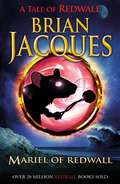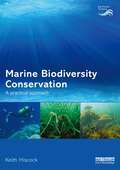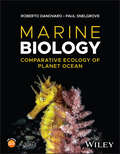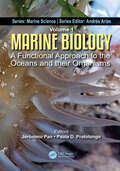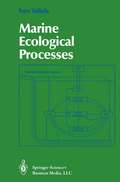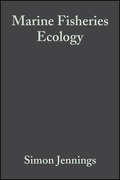- Table View
- List View
Many Things Under a Rock: The Mysteries of Octopuses
by David ScheelA riveting new exploration of the octopus from the world-leading scientific expert. For fans of Netflix's 'My Octopus Teacher' and Other Minds.'Enchanting... enough to melt the stoniest of hearts.' MAIL ON SUNDAY'Scheel brings the world of the octopus vividly alive... a sense of what it might be like to live in their skins.' FINANCIAL TIMES'Fascinating. The deepest of octopus books.' PETER GODFREY-SMITH'I was agog at his accounts. Mind-blowing and soul-expanding' SY MONTGOMERY_________________What is it like to be an octopus?The octopus is a highly intelligent and deeply mysterious creature. It can change colour as quickly as it can move, 'think' with its tentacles and communicate in sophisticated ways.Marine biologist David Scheel's lifelong preoccupation with these animals has led to a career of groundbreaking research, from finding previously unknown species to the discovery of signaling communication. In Many Things Under a Rock, Scheel shares his deep scientific understanding of octopuses and recounts his intrepid adventures with these mysterious, charismatic creatures.He investigates four major mysteries about octopuses: what can we know about such elusive and camouflaged creatures? Why are they so extraordinarily resilient? How do their bodies work? And what kind of relationships do they have? In unravelling these mysteries, Dr Scheel shows octopuses to be complex emotional beings and reveals what they can teach us about ourselves.
Mapping Russia's Natural Focal Diseases: History And Contemporary Approaches (Global Perspectives on Health Geography)
by Svetlana Malkhazova Varvara Mironova Natalia Shartova Dmitry Orlov Vadim Rumyantsev Mikhail SoldatovThis book is the first scientific publication on diseases caused by agents circulating in natural environments independently from humans, covering the whole territory of the Russian Federation. It contains diverse and multifaceted information, both in textual and cartographic form.The book focuses on the historical and current distribution of natural-focal diseases in Russia, epidemiological aspects, natural and socio-economic determinants conducing natural foci. With a series of maps this book depicts population morbidity rates in particular regions and on a national level for the 21st century.With numerous color illustrations this book appeals to a wide audience and is of particular interest to geographers, environmental workers, epidemiologists and other specialists interested in environmental and public health issues.
The Marble Crusher (Mammoth Reads Ser.)
by Michael MorpurgoThree brilliant stories that will captivate young readers by War Horse author and former Children's Laureate, Michael Morpurgo. The Marble Crusher Does Mr Manners, the headmaster, really have a machine that crushes marbles? Albert thinks so. Colly's Barn Colly the owl and Screecher the swallow band together to save the barn. Conker
Marek’s Disease: Scientific Basis and Methods of Control (Developments in Veterinary Virology #1)
by L. N. PayneTake a disease of complex pathology with inflammatory and neoplastic features, which affects lymphoid and neural tissues, belonging to a disease group which killed one chicken in five, and which defied efforts to understand and control it for !lOre than 50 years, and one can begin to appreciate the interest Marek's disease has received. Canpound these characteristics with the finding of the causal herpesvirus, its recog nition as the neoplasm first discovered to be so caused, and its pre vention by vaccination, and the special place of Marek's disease in veterinary medicine and comparative oncology becomes clear. This book sets out to provide an authoritative and corrprehensive account of knowledge of Marek's disease and its control. I hope that it will be of value to veterinary research workers, teachers and students who need information about the disease, to veterinarians, poultrymen and vaccine manufacturers who have to diagnose and control it, and to oncologists in other fields interested in comparative aspects. other reviews of the disease exist, of course, but this is the first multi authored book devoted to the subject.
Mariel Of Redwall (Redwall #4)
by Brian JacquesThe mousemaid Mariel is washed up on the shores of Mossflower country, half-drowned, battered and bruised but still alive! She has no idea of her identity but her incredible story of badger lords, fighting hares and Gabool the Wild Warlord of the Waters gradually unfolds and helps Redwall Abbey in its latest battle against evil sea rats . . .
Marine Biodiversity Conservation: A Practical Approach
by Keith HiscockEffective marine biodiversity conservation is dependent upon a clear scientific rationale for practical interventions. This book is intended to provide knowledge and tools for marine conservation practitioners and to identify issues and mechanisms for upper-level undergraduate and Masters students. It also provides sound guidance for marine biology field course work and professionals. The main focus is on benthic species living on or in the seabed and immediately above, rather than on commercial fisheries or highly mobile vertebrates. Such species, including algae and invertebrates, are fundamental to a stable and sustainable marine ecosystem. The book is a practical guide based on a clear exposition of the principles of marine ecology and species biology to demonstrate how marine conservation issues and mechanisms have been tackled worldwide and especially the criteria, structures and decision trees that practitioners and managers will find useful. Well illustrated with conceptual diagrams and flow charts, the book includes case study examples from both temperate and tropical marine environments.
Marine Biodiversity Conservation: A Practical Approach
by Keith HiscockEffective marine biodiversity conservation is dependent upon a clear scientific rationale for practical interventions. This book is intended to provide knowledge and tools for marine conservation practitioners and to identify issues and mechanisms for upper-level undergraduate and Masters students. It also provides sound guidance for marine biology field course work and professionals. The main focus is on benthic species living on or in the seabed and immediately above, rather than on commercial fisheries or highly mobile vertebrates. Such species, including algae and invertebrates, are fundamental to a stable and sustainable marine ecosystem. The book is a practical guide based on a clear exposition of the principles of marine ecology and species biology to demonstrate how marine conservation issues and mechanisms have been tackled worldwide and especially the criteria, structures and decision trees that practitioners and managers will find useful. Well illustrated with conceptual diagrams and flow charts, the book includes case study examples from both temperate and tropical marine environments.
Marine Biodiversity of Costa Rica, Central America (Monographiae Biologicae #86)
by Ingo S. Wehrtmann Jorge CortésLife began in the sea, and even today most of the deep diversity of the planet is marine. This is often forgotten, especially in tropical countries like Costa Rica, renowned for their rain forests and the multitude of life forms found therein. Thus this book focusing on marine diversity of Costa Rica is particularly welcome. How many marine species are there in Costa Rica? The authors report a total of 6,777 species, or 3. 5% of the world’s total. Yet the vast majority of marine species have yet to be formally described. Recent estimates of the numbers of species on coral reefs range from 1–9 million, so that the true number of marine species in Costa Rica is certainly far higher. In some groups the numbers are likely to be vastly higher because to date they have been so little studied. Only one species of nematode is reported, despite the fact that it has been said that nematodes are the most diverse of all marine groups. In better studied groups such as mollusks and crustaceans, reported numbers are in the thousands, but even in these groups many species remain to be described. Indeed the task of describing marine species is daunting – if there really are about 9 million marine species and Costa Rica has 3. 5% of them, then the total number would be over 300,000. Clearly, so much remains to be done that new approaches are needed. Genetic methods have en- mous promise in this regard.
Marine Biological Materials of Invertebrate Origin: Invertebrates (Biologically-Inspired Systems #13)
by Hermann EhrlichThe work is a source of modern knowledge on biomineralization, biomimetics and bioinspired materials science with respect to marine invertebrates. The author gives the most coherent analysis of the nature, origin and evolution of biocomposites and biopolymers isolated from and observed in the broad diversity of marine invertebrate organisms and within their unusual structural formations. The basic format is that of a major review article, with liberal use of references to original literature. There is a wealth of new and newly synthesized information, including dozens of previously unpublished images of unique marine creatures and structures from nano- to microscale including high-resolution scanning and transmission electron micrographs. The material is organized effectively along both biological (phyla) and functional lines. The classification of biological materials of marine origin is proposed and discussed. Much of the pertinent data is organized into tables, and extensive use is made of electron micrographs and line drawings. Several modern topics e.g. “biomineralization- demineralization-remineralization phenomena”, or “phenomenon of multiphase biomineralization”, are discussed in details. Traditionally, such current concepts as hierarchical organization of biocomposites and skeletal structures, structural bioscaffolds, biosculpturing, biomimetism and bioinspiration as tools for the design of innovative materials are critically analyzed from both biological and materials science point of view using numerous unique examples of marine origin. This monograph reviews the most relevant advances in the marine biomaterials research field, pointing out several approaches being introduced and explored by distinct laboratories.
Marine Biology: Comparative Ecology of Planet Ocean
by Roberto Danovaro Paul SnelgroveMARINE BIOLOGY Marine Biology: Comparative Ecology of Planet Ocean provides a learning tool to those who love the ocean to help them understand and learn about the life that populates it, the extraordinary adaptations of marine organisms to their environment, and the spectacular variety of marine life forms that inhabit the many marine habitats and contribute to the life support system of Planet Ocean. The book introduces marine biology by seeing the ocean through the eyes of its inhabitants, describing the properties of sea water, the surface waters and its currents, and the characteristics of the seabed according to how marine organisms perceive, exploit, and shape them. This book explains to the reader and those who love the ocean not only how to recognize the most common marine organisms and habitats, from the coast to great depths, but it also explains their complex life cycles and the environmental factors controlling their distribution, reproduction, and growth. Finally, the book evaluates the role that living biota play in how different marine ecosystems function in order to understand better their characteristics, peculiarities, and threats. This book offers an up-to-date and comprehensive text on the study of marine biology, presenting insights into the methodologies scientists have adopted for the study of marine ecosystems. It also includes chapters about human impacts on marine biodiversity, from overfishing to climate change, from pollution (including microplastics), to alien-species invasions, from conservation of marine resources to the restoration of degraded marine habitats. The authors developed this text for Bachelor and Master’s level students taking classes on marine biology and marine ecology, but it will also interest high-school students and marine enthusiasts (dive masters, tour guides) who wish to deepen their knowledge of marine biology.
Marine Biology: Comparative Ecology of Planet Ocean
by Roberto Danovaro Paul SnelgroveMARINE BIOLOGY Marine Biology: Comparative Ecology of Planet Ocean provides a learning tool to those who love the ocean to help them understand and learn about the life that populates it, the extraordinary adaptations of marine organisms to their environment, and the spectacular variety of marine life forms that inhabit the many marine habitats and contribute to the life support system of Planet Ocean. The book introduces marine biology by seeing the ocean through the eyes of its inhabitants, describing the properties of sea water, the surface waters and its currents, and the characteristics of the seabed according to how marine organisms perceive, exploit, and shape them. This book explains to the reader and those who love the ocean not only how to recognize the most common marine organisms and habitats, from the coast to great depths, but it also explains their complex life cycles and the environmental factors controlling their distribution, reproduction, and growth. Finally, the book evaluates the role that living biota play in how different marine ecosystems function in order to understand better their characteristics, peculiarities, and threats. This book offers an up-to-date and comprehensive text on the study of marine biology, presenting insights into the methodologies scientists have adopted for the study of marine ecosystems. It also includes chapters about human impacts on marine biodiversity, from overfishing to climate change, from pollution (including microplastics), to alien-species invasions, from conservation of marine resources to the restoration of degraded marine habitats. The authors developed this text for Bachelor and Master’s level students taking classes on marine biology and marine ecology, but it will also interest high-school students and marine enthusiasts (dive masters, tour guides) who wish to deepen their knowledge of marine biology.
Marine Biology
by Jeffrey LevintonLevinton's Marine Biology is highly acclaimed and regarded by many as the best, most authoritative text for the sophomore/junior/senior marine biology course. The text is characterized by its exceptionally clear and conversational writing style, comprehensive coverage, and sophisticated presentation featuring organismal and ecosystem ecology topics from an evolutionary perspective. Over the course of five editions, Jeff Levinton has balanced his organismal and ecological focus by including the latest developments from the world of molecular biology, global climate change, and oceanic processes.
Marine Biology: A Functional Approach to the Oceans and their Organisms (Marine Science Series)
by Jerónimo PanWe present you with an updated reference book aimed for upper-level undergraduate and graduate students interested in Marine Biology. The textbook is designed to introduce the fundamentals of marine organisms and their ecological roles in the world’s oceans, and is organized by functional groups, emphasizing marine biodiversity rather than systematics or habitats. Each chapter has been written and peer-reviewed by renowned international experts in their respective fields, and includes updated information on relevant topics, from the microbial loop and primary production in the oceans, to marine megafauna and the impacts of projected climate change on marine life and ecosystems.
Marine Biology: A Functional Approach to the Oceans and their Organisms (Marine Science Series)
by Jerónimo Pan Paula PratolongoWe present you with an updated reference book aimed for upper-level undergraduate and graduate students interested in Marine Biology. The textbook is designed to introduce the fundamentals of marine organisms and their ecological roles in the world’s oceans, and is organized by functional groups, emphasizing marine biodiversity rather than systematics or habitats. Each chapter has been written and peer-reviewed by renowned international experts in their respective fields, and includes updated information on relevant topics, from the microbial loop and primary production in the oceans, to marine megafauna and the impacts of projected climate change on marine life and ecosystems.
Marine Coastal Ecosystems Modelling and Conservation: Latin American Experiences
by Marco Ortiz Ferenc JordánThe book presents a collection of large-scale network-modeling studies on coastal systems in Latin America. It includes a novel description of the functioning of coastal complex ecosystems and also predicts how natural and human-made disturbances percolate through the networks. Coastal areas belong to the most populated ecosystems around the globe, and are massively influenced by human impacts such as shipping, mining, fisheries, tourism, pollution and human settlements. Even though many of these activities have facilitated socio-economic development, they have also caused a significant deterioration in natural populations, communities and ecosystems worldwide. Covering coastal marine ecosystems of Latin America such as the NE and SE Pacific, NW Atlantic and Caribbean areas, it discusses the construction of quantitative (Ecopath-Ecosim-Ecospace and Centrality of Node Sets) and semi-quantitative (Loop Analysis) multispecies trophic-network models to describe and assess the impacts of natural and human interventions like pelagic and benthic fishing as well as natural events such as El Niño, and La Niña. The book also features steady state (and/or near moving equilibrium) and dynamical models to support the management of exploited organisms, and applies and quantifies macroscopic indices, based on Ascendency (Ulanowicz) and Local Stability (Levins´ Loop Analysis). Further, it discusses the determination of the Keystone Species Complex Index, which is a holistic extension of the classical concept of Keystone Species (Paine), offering novel strategies for conservation monitoring and management.
Marine Ecological Processes
by I. ValielaMarine Ecological Processes is a modern review and synthesis of marine ecology that provides the reader - particularly the graduate student - with a lucid introduction to the intellectual concepts, approaches, and methods of this evolving discipline. Comprehensive in its coverage, this book focuses on the processes controlling marine ecosystems, communities, and populations and demonstrates how general ecological principles - derived from terrestrial and freshwater systems as well - apply to marine ecosystems. Numerous illustrations, examples, and references clearly impart to the reader the current state of research in this field; its achievements as well as unresolved controversies.
Marine Ecological Processes (Springer Advanced Texts in Life Sciences)
by Ivan ValielaThis text is aimed principally at the beginning graduate or advanced undergraduate student, but was written also to serve as a review and, more ambitiously, as a synthesis of the field. To achieve these purposes, several objectives were imposed on the writing. The first was, since ecol ogists must be the master borrowers of biology, to give the flavor of the eclectic nature of the field by providing coverage of many of the interdis ciplinary topics relevant to marine ecology. The second objective was to portray marine ecology as a discipline in the course of discovery, one in which there are very few settled issues. In many instances it is only possible to discuss diverse views and point out the need for further study. The lack of clear conclusions may be frustrating to the beginning student but nonetheless reflects the current-and necessarily exciting-state of the discipline. The third purpose is to guide the reader further into topics of specialized interest by providing sufficient recent references especially reviews. The fourth objective is to present marine ecology for what it is: a branch of ecology. Many concepts, approaches, and methods of marine ecology are inspired or derived from terrestrial and limnological antecedents. There are, in addition, instructive comparisons to be made among results obtained from marine, freshwater, and terrestrial environ ments, I have therefore incorporated the intellectual antecedents of par ticular concepts and some non-marine comparisons into the text.
Marine Ecological Processes (Springer Advanced Texts In Life Sciences Ser.)
by Ivan ValielaThe oceans represent a vast, complex and poorly understood ecosystem. Marine Ecological Processes is a modern review and synthesis of marine ecology that provides the reader with a lucid introduction to the intellectual concepts, approaches, and methods of this evolving discipline. Comprehensive in its coverage, this book focuses on the processes controlling marine ecosystems, communities, and populations and demonstrates how general ecological principles--derived from terrestrial and freshwater systems as well--apply to marine ecosystems.Global warming and increased eutrophication and wetland destruction in recent years has made the study of ecological processes even more important for the preservation of marine environments. This thoroughly updated and expanded edition will provide students of marine ecology, marine biology, and oceanography with numerous illustrations, examples, and references which clearly impart to the reader the current state of research in this field: its achievements as well as unresolved controversies.
Marine Ecology: Concepts and Applications
by Martin R. Speight Peter A. HendersonThis book began life as a series of lectures given to second and third year undergraduates at Oxford University. These lectures were designed to give students insights as to how marine ecosystems functioned, how they were being affected by natural and human interventions, and how we might be able to conserve them and manage them sustainably for the good of people, both recreationally and economically. This book presents 10 chapters, beginning with principles of oceanography important to ecology, through discussions of the magnitude of marine biodiversity and the factors influencing it, the functioning of marine ecosystems at within trophic levels such as primary production, competition and dispersal, to different trophic level interactions such as herbivory, predation and parasitism. The final three chapters look at the more applied aspects of marine ecology, discussion fisheries, human impacts, and management and conservation. Other textbooks covering similar topics tend to treat the topics from the point of view of separate ecosystems, with chapters on reefs, rocks and deep sea. This book however is topic driven as described above, and each chapter makes full use of examples from all appropriate marine ecosystems. The book is illustrated throughout with many full colour diagrams and high quality photographs. The book is aimed at undergraduate and graduate students at colleges and universities, and it is hoped that the many examples from all over the world will provide global relevance and interest. Both authors have long experience of research and teaching in marine ecology. Martin Speight’s first degree was in marine zoology at UCNW Bangor, and he has taught marine ecology and conservation at Oxford for 25 years. His research students study tropical marine ecology from the Caribbean through East Africa to the Far East. Peter Henderson is a Senior Research Associate at the University of Oxford, and is Director of Pisces Conservation in the UK. He has worked on marine and freshwater fisheries, as well as ecological and economic impacts and exploitation of the sea in North and South America as well as Europe.
Marine Ecology: Concepts and Applications
by Martin R. Speight Peter A. HendersonThis book began life as a series of lectures given to second and third year undergraduates at Oxford University. These lectures were designed to give students insights as to how marine ecosystems functioned, how they were being affected by natural and human interventions, and how we might be able to conserve them and manage them sustainably for the good of people, both recreationally and economically. This book presents 10 chapters, beginning with principles of oceanography important to ecology, through discussions of the magnitude of marine biodiversity and the factors influencing it, the functioning of marine ecosystems at within trophic levels such as primary production, competition and dispersal, to different trophic level interactions such as herbivory, predation and parasitism. The final three chapters look at the more applied aspects of marine ecology, discussion fisheries, human impacts, and management and conservation. Other textbooks covering similar topics tend to treat the topics from the point of view of separate ecosystems, with chapters on reefs, rocks and deep sea. This book however is topic driven as described above, and each chapter makes full use of examples from all appropriate marine ecosystems. The book is illustrated throughout with many full colour diagrams and high quality photographs. The book is aimed at undergraduate and graduate students at colleges and universities, and it is hoped that the many examples from all over the world will provide global relevance and interest. Both authors have long experience of research and teaching in marine ecology. Martin Speight’s first degree was in marine zoology at UCNW Bangor, and he has taught marine ecology and conservation at Oxford for 25 years. His research students study tropical marine ecology from the Caribbean through East Africa to the Far East. Peter Henderson is a Senior Research Associate at the University of Oxford, and is Director of Pisces Conservation in the UK. He has worked on marine and freshwater fisheries, as well as ecological and economic impacts and exploitation of the sea in North and South America as well as Europe.
Marine Fisheries Ecology
by Simon Jennings Michel Kaiser John D. ReynoldsThis topical and exciting textbook describes fisheries exploitation, biology, conservation and management, and reflects many recent and important changes in fisheries science. These include growing concerns about the environmental impacts of fisheries, the role of ecological interactions in determining population dynamics, and the incorporation of uncertainty and precautionary principles into management advice. The book draws upon examples from tropical, temperate and polar environments, and provides readers with a broad understanding of the biological, economic and social aspects of fisheries ecology and the interplay between them. As well as covering 'classical' fisheries science, the book focuses on contemporary issues such as industrial fishing, poverty and conflict in fishing communities, marine reserves, the effects of fishing on coral reefs and by-catches of mammals, seabirds and reptiles. The book is primarily written for students of fisheries science and marine ecology, but should also appeal to practicing fisheries scientists and those interested in conservation and the impacts of humans on the marine environment. particularly useful are the modelling chapters which explain the difficult maths involved in a user-friendly manner describes fisheries exploitation, conservation and management in tropical, temperate and polar environments broad coverage of 'clasical' fisheries science emphasis on new approaches to fisheries science and the ecosystem effects of fishing examples based on the latest research and drawn from authors' international experience comprehensively referenced throughout extensively illustrated with photographs and line drawings
Marine Fishes of Florida
by David B. Snyder George H. BurgessThe most comprehensive book about Florida's marine fishes ever produced, Marine Fishes of Florida includes hundreds of photographs and descriptions of species you'll encounter;¢;‚¬;€?plus many that are rare;¢;‚¬;€?when diving, snorkeling, kayaking, or fishing. Coverage includes both the Atlantic and Gulf coastline, from habitats near the shore to deeper waters. Fishes found in coastal rivers and other brackish waters are fully represented, as are offshore species that venture into Florida's waters often enough to be called "occasional visitors." David B. Snyder and George H. Burgess intertwine personal observations with results from research studies to provide accurate;¢;‚¬;€?often surprising;¢;‚¬;€?details. The result is a set of beautifully succinct identification descriptions coupled with information about each species' natural history. From the largest sharks to the smallest cryptic gobies, from homely toadfishes to the spectacularly colored reef fishes, this book is certain to help you better understand the fish you've seen or hooked.Features of Marine Fishes of Florida include Color photographs by leading marine photographers Differentiation of adult and juvenile forms Coverage of 133 fish families and hundreds of species Size and geographical range data Natural history and conservation notes Explanations of geologic history and current habitats
Marine Fishes of Florida
by David B. Snyder George H. BurgessThe most comprehensive book about Florida's marine fishes ever produced, Marine Fishes of Florida includes hundreds of photographs and descriptions of species you'll encounter;¢;‚¬;€?plus many that are rare;¢;‚¬;€?when diving, snorkeling, kayaking, or fishing. Coverage includes both the Atlantic and Gulf coastline, from habitats near the shore to deeper waters. Fishes found in coastal rivers and other brackish waters are fully represented, as are offshore species that venture into Florida's waters often enough to be called "occasional visitors." David B. Snyder and George H. Burgess intertwine personal observations with results from research studies to provide accurate;¢;‚¬;€?often surprising;¢;‚¬;€?details. The result is a set of beautifully succinct identification descriptions coupled with information about each species' natural history. From the largest sharks to the smallest cryptic gobies, from homely toadfishes to the spectacularly colored reef fishes, this book is certain to help you better understand the fish you've seen or hooked.Features of Marine Fishes of Florida include Color photographs by leading marine photographers Differentiation of adult and juvenile forms Coverage of 133 fish families and hundreds of species Size and geographical range data Natural history and conservation notes Explanations of geologic history and current habitats
Marine Genetic Resources, R&D and the Law 1: Complex Objects of Use
by Bleuenn GuillouxAdvances in research and development reveal the immense diversity and potential of marine genetic resources. Under international law, no specific regime applies to these complex and paradoxical objects of use. The Law of the Sea Convention sets a framework that is partly inadequate for this new category of resources. The Biodiversity Convention and the Nagoya Protocol only address the genetic resources of national areas. Patents allow their holder to exercise a monopoly on exploiting biotechnological creations to extensive claims, questioning the common nature of biodiversity and related knowledge. They hinder research and the objectives of biodiversity law. The legal and practical rules of physical and functional access vary in geometry. They focus on the valorization of research results, crystallizing conflicts of interest between suppliers and users. Sustainable research and development is essential to the knowledge and protection of marine biodiversity. The qualification of marine genetic resources in common, standard contractual tools, distributed research and development infrastructures, negotiation of an agreement on sustainable use and conservation of biodiversity beyond the limits of national jurisdiction, would To remove these inconsistencies.
Marine Genetic Resources, R&D and the Law 1: Complex Objects of Use
by Bleuenn GuillouxAdvances in research and development reveal the immense diversity and potential of marine genetic resources. Under international law, no specific regime applies to these complex and paradoxical objects of use. The Law of the Sea Convention sets a framework that is partly inadequate for this new category of resources. The Biodiversity Convention and the Nagoya Protocol only address the genetic resources of national areas. Patents allow their holder to exercise a monopoly on exploiting biotechnological creations to extensive claims, questioning the common nature of biodiversity and related knowledge. They hinder research and the objectives of biodiversity law. The legal and practical rules of physical and functional access vary in geometry. They focus on the valorization of research results, crystallizing conflicts of interest between suppliers and users. Sustainable research and development is essential to the knowledge and protection of marine biodiversity. The qualification of marine genetic resources in common, standard contractual tools, distributed research and development infrastructures, negotiation of an agreement on sustainable use and conservation of biodiversity beyond the limits of national jurisdiction, would To remove these inconsistencies.




